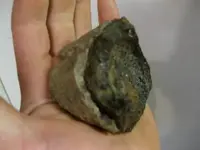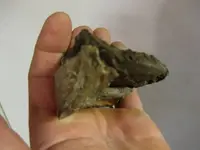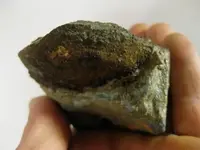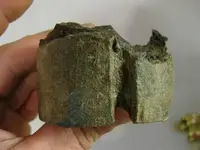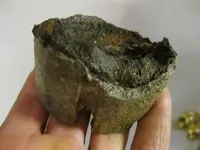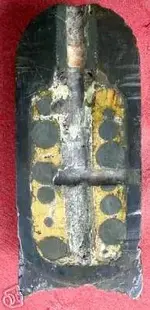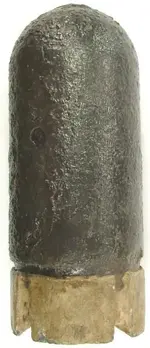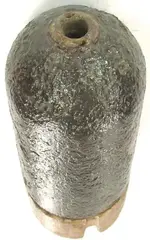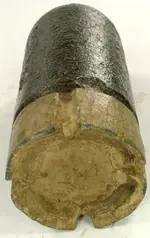Bearbqd wrote:
> What can you tell me about the wooden fuses that these had that were lit by the flame grooves?
These 3"-caliber Dyer shells never used a wood plug for the timefuze adapter plug. US Captain Alexander B. Dyer designed a threaded metal adapter plug to hold the paper timefuze in his 3"-caliber shells. I'll attach photos to show you a Dyer 3"-caliber shells ...and a "halfsection" photo showing a Dyer timefuze-adapter plug, threaded into the fuzehole of a 3"-caliber Dyer Case-Shot. (Remember, the Dyer version you found is a Common-Shell, not a Case-Shot, so yours did not have any antipersonnel balls inside it.) Sorry I don't have a better-looking "halfsection" photo to post.
Just in case you (or other readers) are not familiar with a "paper" timefuze, I'll describe its construction. First... at an Arsenal, black gunpowder was wetted just enough to give it a thick clay-like consistency. While it was claylike, it was packed into a hollow cylinder made of multiple rolled-up layers of heavy paper, similar to today's grocery-sack paper. The paper cylinder was usually about 2 inches long. It was slightly tapered, being about 1/2" wide at one end, and about 3/8" wide at the other end. The outside of the paper cylinder was marked (with ink) like a ruler, except the lines represent seconds of burning-time.
Just prior to firing, the gunner calculates the range to the target, in both yards of distance and seconds of fuze burning-time. Let's say the range to the target was 8.5 seconds. A member of the cannon's crew pulls a 10-second paper timefuze out of the shipping-packet it came in (which usually contained five paper timefuzes per packet). Noting the time-marking lines on the paper fuze, he then would use a fuze-cutter to slice off the un-needed 1.5 seconds from the 10-second fuze's length. He then presses the paper fuze into the 1/2"-wide hole in the fuze-adapter plug in the shell's nose. The "fuzed" shell is then loaded into the cannon. At the instant of firing, the flaming blast from the cannon's propellant powdercharge ignites the exposed tip of the paper timefuze. (During the civil war, an average of one out of four timefuzes failed to ignite, which is why we diggers have found so many "duds" on civil war battlefields.) If today is a good day, the shell will burst
in the air 8.5 seconds after firing, scattering shrapnel among the enemy's troops.
Please note, a timefuze is used only when an airburst is desired. If you wanted to blow up a fort's walls, you would use an impact-detonation fuze ...which in the civil war was called a Percussion fuze. Unlike a time-fuzed shell (which is intended to explode in the air), an impact-fuzed shell doesn't explode until it hits a solid object (or the ground).
> Was there different thickness wood to determine how many seconds it would reach the internal powder charge?
The only such civil war fuze which worked anything like your question is describing is a extremely long-bodied wooden timefuze-plug for use in Heavy Caliber mortars. Being so lengthy, a wooden cylinder was used instead of paper. The rulerlike time-markings were engraved into the wood, instead of printed in ink.
> Finally came out at about 14-16 inches.
For the shell's exploded base to be found
that deep, you very probably found what we shell-diggers call a "groundburst" shell. Meaning, the shell burrowed down into the ground before it exploded. The entire rest of that shell, exploded into fragments, could be down in that hole, or a little bit off to one side of the hole, at that depth or deeper. So, my Oldtimer's advice to you is to go back to that hole and dig it out wider and deeper, checking it for more readings. Since you'll be looking for iron frags, set your detector to zero discrimination.
In addition to the iron frags, there's a decent chance your shell's solder-alloy Dyer timefuze adapter-plug is also in that hole. If it's not smashed, a Dyer fuzeplug is worth about $50. Good luck!





